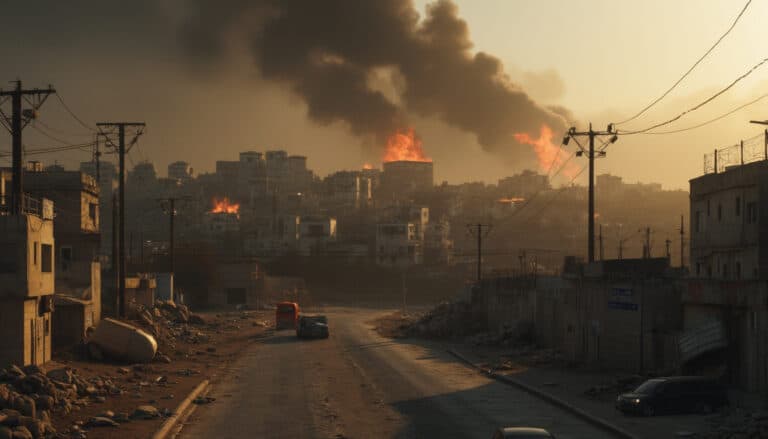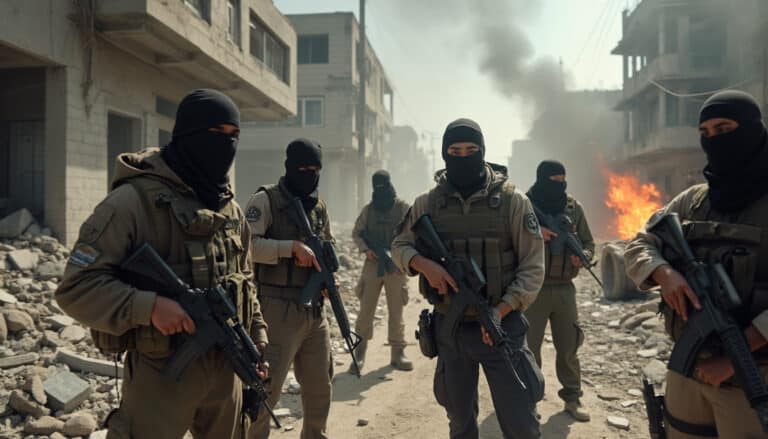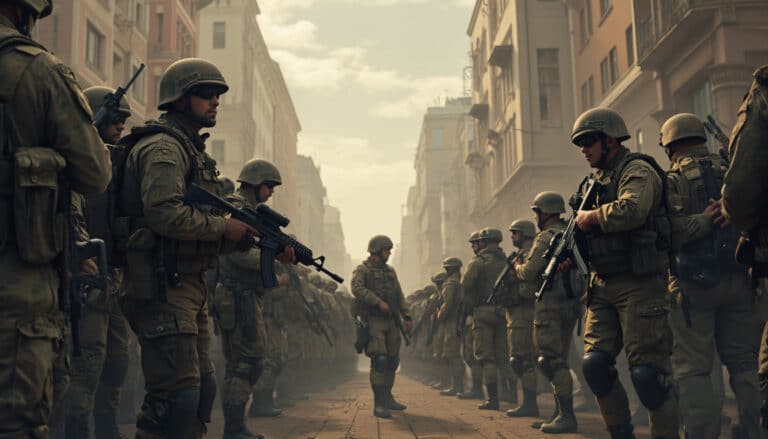The skies above Yemen have not been silent since the beginning of the airstrikes. Every day, explosions resonate, marking an unprecedented military escalation. This relentless campaign raises numerous questions about the strategy and consequences.
Since the beginning of the Trump administration, a series of airstrikes have been carried out targeting various objectives in Yemen, aimed at reopening global shipping routes. Originally, this initiative did not have unanimous support within the administration, with some high-ranking officials doubting the effectiveness of this approach against the Houthis, perceived as proxies of Iran. Internal critics, like Mike Waltz, highlighted the high financial cost of these operations, estimated at tens of billions of dollars.
The recent revelation of a discussion group that even included journalists, involved in the planning of these strikes, has intensified debates. Despite the criticisms, the Trump administration defended these actions as a success, asserting that they represented a return to American strength after years of “deferred maintenance” policy under the Biden administration. However, experts point to a concerning continuity with previous strategies, despite an escalation of attacks.
The strikes have significantly increased since last year, but they continue to face the same obstacles as those carried out by the Biden administration. The goal of degrading the Houthis’ ability to control shipping lanes and secure global trade seems difficult to achieve. Michael Knights, an analyst at the Washington Institute for Near East Policy, emphasizes that “making the Houthis cry out for mercy is highly unlikely.”
In response to the increased attacks, the U.S.-led coalition has bolstered its military presence in the Red Sea, deploying aircraft carriers, destroyers, and other ships to escort commercial vessels. Meanwhile, regular strikes against Houthi sites have been intensified, now targeting more command and air defense structures, often near civilian areas.
Despite these efforts, experts believe that the shipping lanes will remain closed for months, if not indefinitely, due to the resilience and ongoing support of the Houthis, primarily funded by Iran. Ben Friedman, an analyst at Defense Priorities, criticizes the air campaign, arguing that it will not resolve the underlying issues of the conflict and that more nuanced strategies are needed to achieve lasting peace.
Table des matières
ToggleWhat was the initial positioning of the Trump administration on the Houthis?
When Donald Trump took office in January 2017, his administration quickly adopted a firm stance against the Houthis, a Shiite faction in Yemen supported by Iran. Unlike some members of his team, such as former representative Mike Waltz, who became national security advisor and doubted the effectiveness of attacks against what they considered an “Iranian proxy terrorist group,” the administration nonetheless persisted in its military campaign. This decision was partly motivated by the need to reopen global trade routes crossing the Bab el-Mandeb Strait, essential for international trade.
What were the internal concerns regarding airstrikes?
Even before Trump officially took office, voices within the administration expressed reservations about bombing the Houthis. Elbridge Colby, appointed head of Pentagon policy, criticized the strategy online on X, pointing out the lack of concrete prospects for success of the strikes. This concern reflects a division within the Trump team on the best approach to take in response to the complex situation in Yemen, where the Houthis could quickly reconstitute their capabilities with Iranian support.
How did the Trump team strengthen airstrikes?
Since March 2024, under the impetus of the Trump administration, more than 100 airstrikes have been carried out against Houthi targets in Yemen. This escalation included direct attacks against enemy leaders and vital infrastructure, marking a significant shift from the previous administration, which primarily targeted military installations such as munitions depots. The increased use of advanced technologies, similar to those discussed in this article, enabled greater precision, although critics point out that these strikes have not resolved the conflict sustainably.
What continuity exists with the Biden administration’s strategy?
Despite changes in tactics, the approach to airstrikes under Trump exhibits notable continuity with that of the Biden administration. Both administrations recognized the resilience of the Houthis, supported by Iran, and the necessity of maintaining constant military pressure. Daniel Shapiro, a former Pentagon policy official for the Middle East, noted that “not underestimating the resilience of the Houthis” was a key lesson learned previously, thus influencing the continuation of strikes to weaken this faction. This continuity is also observable in the increased oversight of shipping lanes, a measure similar to those described in this article on Russian military forces.
What have been the impacts of the new strikes on the ground?
The consequences of the intensified strikes have been multiple. On one hand, they have temporarily secured some critical shipping lanes, but on the other hand, they have failed to completely disintegrate the capabilities of the Houthis. The increase in strikes has also led to a rise in regional tensions and an acceleration of militarization in already unstable areas. The use of sophisticated military aircraft has certainly enhanced the effectiveness of operations but has also raised concerns about civilian casualties and the destruction of civilian infrastructure in Yemen.
How have international reactions influenced American strategy?
In response to the intensification of strikes, international reactions have been mixed. Some long-term allies of the United States have expressed reservations about military escalation, highlighting the risks of prolonging the conflict and intensifying the humanitarian crisis in Yemen. Others have supported the American position, recognizing the threat posed by the Houthis in the region. The Trump administration has often justified its actions by asserting a return to American strength, a narrative aimed at restoring the military credibility of the United States after what it considered years of “deferred maintenance” under Biden.
What role does Iran play in the conflict and how does the Trump administration respond?
Iran is widely recognized as the primary supporter of the Houthis, providing weapons, funding, and training to enhance their military capacity. The Trump administration has intensified its measures against Iran, including additional sanctions and direct threats should Iranian support continue. This aggressive stance towards Iran is reflected in the rhetoric adopted by Trump on social media platforms, where he threatened Iran with severe retaliation if support for the Houthis persisted. This approach has been facilitated by the increased introduction of electronic warfare equipment in military operations, allowing for improved monitoring and precision in strikes against Iranian-supported targets.
What are the future challenges for American strategy in Yemen?
The continuation of airstrikes presents several challenges for the Trump administration. One of the main obstacles is the ability of the Houthis to reorganize and maintain their operations despite ongoing strikes. The integration of advanced systems such as sophisticated fighter jets and guided munitions has certainly improved strike effectiveness, but has not been sufficient to completely eliminate the threat. Furthermore, the increased reliance on airstrikes has incurred significant costs in terms of military readiness, a concern raised by policymakers like Mike Waltz, who criticized the “burning of readiness” of American armed forces.
How do military technologies influence the bombing campaign?
The increasing use of advanced military technologies, including military aircraft and guided munitions, has transformed how the United States conducts its operations in Yemen. These technologies allow not only for greater precision in attacks, potentially reducing collateral damage, but they also enhance the speed and effectiveness of strikes. For example, iconic military aircraft like the F-35 are essential for carrying out precise strike campaigns against strategic Houthi targets. However, the increased use of these technologies requires constant maintenance and specialized training, posing long-term logistical and financial challenges.
How does the Trump administration handle internal and external criticisms?
In the face of both internal and external criticisms, the Trump administration has adopted a resolutely defensive approach, highlighting the perceived successes of airstrikes and emphasizing the necessity to maintain constant pressure on the Houthis. Official communication stresses the security of shipping lanes and the reduction of the Iranian threat, while downplaying concerns regarding civilian casualties. This communication strategy aims to solidify domestic support while managing international relations through calibrated displays of strength. However, this approach has not completely alleviated criticisms regarding the long-term effectiveness of the military campaign and the humanitarian implications of the continuation of bombings.
What future is envisioned for peace in Yemen under the Trump administration?
Despite intensified military efforts, the future of peace in Yemen remains uncertain. Continuous strikes may temporarily weaken the Houthis, but they also risk prolonging the conflict by fueling resentment and strengthening the group’s determination. The absence of robust diplomatic solutions and inclusive dialogues with all stakeholders further complicates the prospect for lasting peace. Meanwhile, humanitarian initiatives remain crucial to alleviate civilian suffering, although the emphasis on military power may divert attention and resources needed for a more comprehensive and peaceful approach.

























